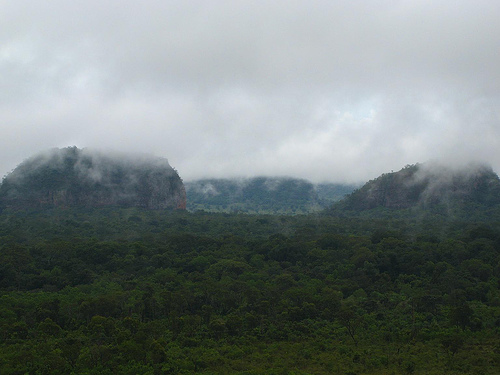

Location: Amambay Department Map
Area: 12.038 ha
Cerro Corá National Park (Parque Nacional Cerro Corá) is Paraguay's largest protected area, encompassing approximately 5,538 hectares (about 13,694 acres) in the Amambay Department, northeastern Paraguay, near the border with Brazil. Established on February 11, 1976, it serves as both a vital nature reserve and a profound historical site, commemorating the final battle of the Paraguayan War (also known as the War of the Triple Alliance) in 1870. The park's name, meaning "corral of hills" in Guarani, reflects its ring-shaped geological structure and surrounding hills, blending natural beauty with cultural heritage. As part of Paraguay's National System of Protected Areas, it protects diverse ecosystems while honoring indigenous and historical legacies, making it a key destination for ecotourism and education.
The park is situated 45 km from Pedro Juan Caballero, the
departmental capital, and about 454 km northeast of Asunción, Paraguay's
capital, at coordinates around 22°39′S 56°11′W. Its terrain features a
unique ring-shaped geological formation of isolated, abrupt hills
(buttes) and escarpments, including prominent peaks like Cerro Corá,
Cerro Muralla (with sheer, wall-like cliffs), Ponta Porá, Guazu, Tacuru
Pytâ, Alambique, Miron, Tanqueria, and Tangaro. Elevations range up to
around 600 meters, with a mosaic of ecosystems including dense forests,
open savannas, wetlands, ecotones, riverbanks, and small rocky outcrops.
The Aquidabán River and its tributaries, such as Aquidabán Nigui Brook,
flow through the park, creating recreational areas and supporting
hydrological diversity.
The climate is subtropical, with warm
temperatures averaging 22-25°C (72-77°F) year-round and high humidity.
Annual rainfall is abundant, around 1,500-2,000 mm, with a pronounced
wet season from October to April (peaking in summer) and a drier period
from May to September. This supports lush vegetation but can lead to
muddy trails during rains, while the dry season offers milder conditions
for exploration.
Cerro Corá is steeped in history as the site of the final battle of
the Paraguayan War (1864-1870), where Paraguayan President Francisco
Solano López was killed on March 1, 1870, near Aquidabán Nigui Brook,
uttering his famous last words: "I die along with my country." This
devastating conflict against the Triple Alliance (Brazil, Argentina,
Uruguay) resulted in Paraguay losing 40% of its territory and a massive
population decline. The park preserves this legacy through monuments, a
museum, and memorials, including the Immolation Site of López and a
large cross.
Culturally, the area features ancient petroglyphs and
rock inscriptions in caves, dated up to 5,000 years old, studied by
teams from the National Museum and Research Center of Altamira in 2008.
These engravings, possibly Guarani or pre-Columbian, highlight early
human presence and add anthropological value. The Paï Tavytera (Guarani)
indigenous people inhabit the region, maintaining spiritual connections
to the land and traditions.
Cerro Corá boasts rich biodiversity, transitioning between cerrado
(savanna-like) ecosystems and high forests, supporting endemic and
threatened species.
Flora: Vegetation includes cerrado species like
yatay palm (Butia paraguayensis), mbokaja’i (Allagoptera leucocalyx),
Duguetia furfuracea, Arnica del campo (Viguiera linearifolia, endemic to
Paraguay), Jacaranda decurrens, yva hai ñu (Casimirella guaranitica,
genus endemic to Paraguay), quebracho, lapacho, ñangapiry (Eugenia
uniflora), Myrciaria ciliolata, Myrcia obtecta, ka’a oveti (Luehea
divaricata), and Gomidesia sellowiana. Forests feature broad-leaved
trees, shrubs, and vibrant plants that bloom seasonally.
Fauna: Over
300 bird species, including harpy eagle (Harpia harpyja), jabiru stork
(Jabiru mycteria), hyacinth macaw (Anodorhynchus hyacinthinus), and
others like bearded guan and torrent duck. Mammals include jaguar
(Panthera onca), tapir (Tapirus terrestris), capuchin monkeys (Cebus
spp.), peccaries (Tayassu spp.), dwarf deer, ocelots, coatis,
armadillos, and venados. Bats: 15 species (of Paraguay's 55), including
the threatened Macrophyllum macrophyllum. Other fauna: Reptiles,
amphibians, fish, and insects.
As Paraguay's first and largest national park, Cerro Corá was established to combat deforestation, hunting, and habitat loss, preserving its unique cerrado-forest transition and hydrological resources. It safeguards endangered species, endemic flora, and cultural sites like petroglyphs, while mitigating threats from invasive exotic grasses, fire, medicinal plant extraction, commercial hunting (e.g., armadillos, peccaries, deer, fish, partridges), and tourism disturbances. Managed by the Secretaría del Ambiente (SEAM) and the Dirección General de Protección y Conservación de la Biodiversidad, it promotes education and sustainable use, including with over 100 local schools. Its role in the Atlantic Forest corridor enhances regional connectivity.
Key attractions include historical sites like the Immolation Site of
Francisco Solano López (with plaques, bust, and walkway), Cerro Corá
Monument (contemporary sculpture), Gran Cross, and a museum detailing
the war. Cultural highlights: Petroglyph caves with ancient engravings.
Natural features: Cerro Muralla for panoramic views, Aquidabán River
recreation areas, waterfalls, and trails like Sendero del Hombre de los
Años and Sendero de la Selva.
Activities: Hiking on varied trails
(moderate to challenging), birdwatching (early mornings best), wildlife
observation, photography at lookouts and waterfalls, picnicking, and
cultural tours with indigenous insights. Guided tours available for
history and ecology.
Access: From Asunción, take a 6-7 hour bus (e.g., Nueva Asunción
S.A., ~US$15) to Pedro Juan Caballero. From there, taxis (~US$10-15, 30
min) or buses drop at the entrance (30 km away); walk 500m to main
sites. Nearest airport: Asunción (ASU), with regional options in Pedro
Juan Caballero (no commercial flights).
Entry and Regulations: Open
daily 7 AM-5 PM; no entrance fee or permits required. Facilities:
Visitors' center, auditorium, guards, guides, restrooms, informational
kiosks.
Best Time to Visit: Dry season (May-September) for hiking and
milder weather; wet season (October-April) for vibrant flora but
slippery trails.
Accommodations: Free camping at equipped sites
(toilets, showers, shelters, tables); nearby hotels in Pedro Juan
Caballero.
Practical Tips: Wear sturdy shoes, long clothes for
insects; bring water, snacks, sunscreen, hat, binoculars, camera. Stay
on trails, keep quiet for wildlife, hire guides for depth. Respect
indigenous communities; check weather and entry in advance. Visit on Día
de los Héroes for events, but expect crowds.
This park offers a
profound blend of Paraguay's natural splendor and historical depth,
ideal for immersive, low-impact exploration.